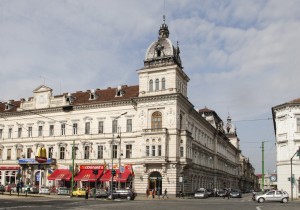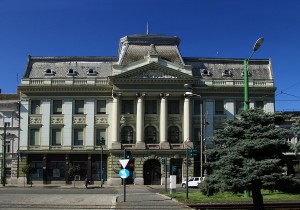Built in 1892 at the request of Arad-Cenad Railway Company and designed in the studio of the architect Miklos Ybl from Budapest, the neo-Renaissance building embellishes the central area of Arad, marking the urban landscape with its beauty.
History
The building was built between 1892-1894 by Arad-Cenad Railway Company. The plans were made in the workshop of architect Miklós Ybl in Budapest and subsequently adapted by architect Lajos Jiraszek.
Originally, the Palace was the seat of Arad-Cenad Railway Company, and came into use in 1887. After the Democratic Revolution of 1989, the halls of Cenad Palace have hosted the offices of political parties, members of the Parliament and various non-governmental associations.
Architecture
The edifice is one of the buildings that were part of the urban ensemble development of the City Hall Square. The buildings had in common the fact that they were built in eclectic style, combined with neo-classical style.
The Cenad Palace, with eclectic references, is distinguished by its façade decorated with stylistic elements of the Italian Renaissance, the two towers at the corners, four input gates, and the “Railway Society” symbol.
The building in neo-renaissance style still retains mural paintings with religious or allegorical subjects under the three gateways. In the courtyard, two gas chandeliers have been preserved. On the frontispiece of the Palace, the figure of Mercury, God of Commerce, is represented.
Interesting facts
The building is part of the urban ensemble of the City Hall Square, build in a clash of styles, namely neoclassical and eclectic, with rich decorative elements that betray its functionality.
Inside the Palace, on the vault of the house stairs with entrance on Revolution Blvd., an old mural painting representing a scene with St. George with the dragon killed on a railway line.
Count Želenski Robert (1850-1939) was an aristocrat, Member of the Parliament, President of the Agricultural Association of Arad County and one of the main founders of the United Railways Csanád-Arad.
Similar tourist attractions
The Administrative Palace of Arad is a significant work of eclectic architecture, currently hosting the City Hall of the municipality and the Institution of the Prefect of Arad County.
Neumann Palace, built in the past as a private residence with a special architecture, accommodates today commercial spaces and spaces of „Vasile Goldiș” Western University of Arad.
The building of the National Bank was raised during 1909- 1910 and projected by architect József Hubert from Budapest. The central part of the edifice was made by the model of Greek temples.





